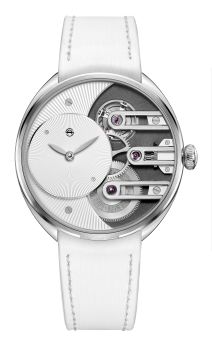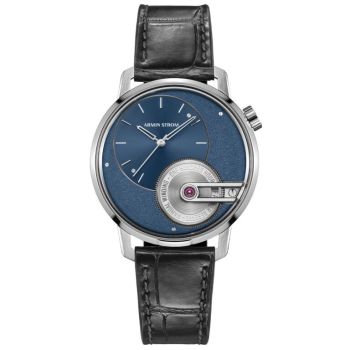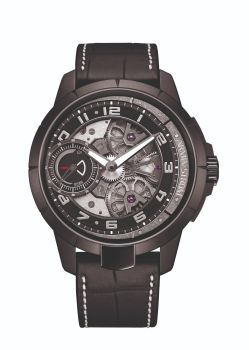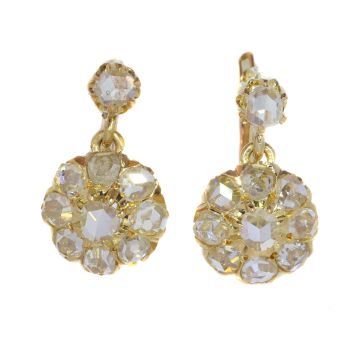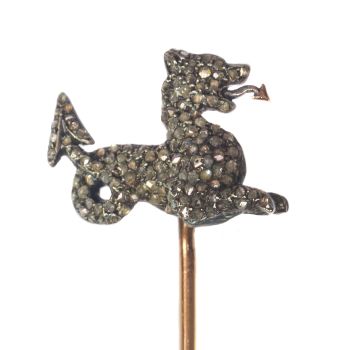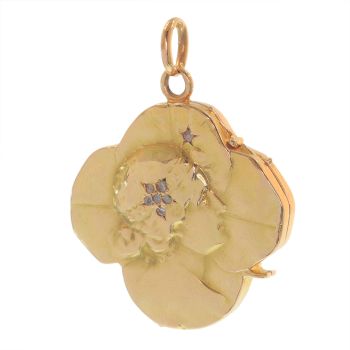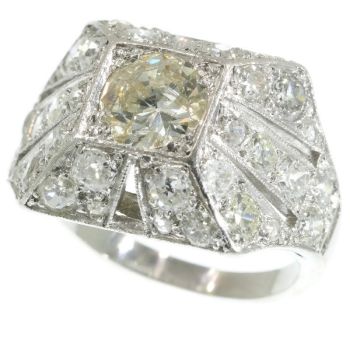Vintage Art Deco platinum ladies wrist watch made by Leon Hatot set with diamonds and sapphires 1920
Leon Hatot
DiamanteZaffiroPietra preziosaPlatino
Attualmente non disponibile tramite Gallerease
- A proposito di opere d'arte
Antique jewelry object group
ladies wrist watch
Condition
very good condition
more info on our condition scale
Country of origin
France
Style
Art Deco - Art Deco is an eclectic artistic and design style which had its origins in Paris in the first decades of the 20th century. The style originated in the 1920s and continued to be employed until after World War II. The term "art deco" first sawwide use after an exhibition in 1966, referring to the 1925 Exposition Internationale des Arts Décoratifs et Industriels Modernes that was the culmination of high-end style modern in Paris. Led by the best designers in the decorative arts such asfashion, and interior design, Art Deco affected all areas of design throughout the 1920s and 1930s, including architecture and industrial design, as well as the visual arts such as painting, the graphic arts and film. At the time, this style was seen aselegant, glamorous, functional and modern.
See also: Art Deco
more info on styles
Style specifics
Abstract motives and geometrical forms are quite typical for the Art Deco period. Art Deco moved away from the soft pastels and organic forms of its style predecessor, Art Nouveau, and embraced influences from many different styles and movements of the early 20th century, including Neoclassical, Constructivism, Cubism, Modernism,and Futurism. Its popularity peaked in Europe during the Roaring Twenties and continued strongly in the United States through the 1930s. Although many design movements have political or philosophical roots or intentions, Art Deco was purelydecorative.
Period
ca. 1920
Events & facts of this era, poetry of this era, fashion of this era.
Material
platinum (touchstone tested)
more info on precious metals
Extra information
Leon Hatot (1883-1953) Started in 1911, bought the atelier of Brédillard in Paris and was supplier to the important jewellery houses in quartier Vendôme and of René-Boivin.
Diamonds
Six old brilliant cut with an estimated weight of ± 0.48ct
112 single brilliant cut diamonds (also called 8/8)with an estimated weight of ± 2.00ct
Total diamond count
118 pcs.
Total diamond weight
approx. 2.48 crt with an average colour and clarity F/J, vs/i
All diamond weights, color grades and clarity are approximate since stones are not removed from their mounts to preserve the integrity of the setting.
All diamonds we offer are screened by the I.J.G.C. for whether they are natural or synthetic, and all diamonds in this jewel are 100% guaranteed to be natural.
Precious stones
48 sapphires
It is a very common practice to treat gemstones to intensify their clarity or colour. The item in question has not been tested in this regard.
Birthstones
Diamond is the birthstone (or month stone) for April and sapphire for September.
more info on birthstones
Hallmarks
Mastermark LH for Leon Hatot and the French control mark for platinum representing a dog's head that was in use in France from about 1912.
more info on hallmarks
Dimensions
width case 2,30 cm (0,91 inch)
see picture with a ruler in millimeters and inches
Weight
22,00 gram (14,15 dwt)
- A proposito di opere artista
Léon Hatot (1883 – 1953) era un imprenditore appassionato: creativo, innovativo e soprattutto progressista. Un bambino del suo tempo in realtà, che era affascinato dall'applicazione dei materiali e delle tecniche più recenti.
L'imprenditore e orafo Léon Hatot visitò l'École d'Hologerie di Besançon dal 1895 al 1898 e poi l'École des Beaux Arts, sempre a Besançon. Giovanissimo si stabilisce a Besançon nel 1905 come imprenditore indipendente e si specializza nell'incisione di casse di segnatempo.
Ben presto fondò anche a Parigi un laboratorio per orologiai e gioiellieri. Qui, coadiuvato da un gran numero di artigiani, realizza orologi di alta qualità, utilizzando speciali metalli preziosi. A quel tempo, Hatot era uno dei pochi a produrre orologi e gioielli. Li fornì alle più importanti case commerciali di rue de la Paix a Parigi.
Curioso e con uno sguardo rivolto al futuro, Hatot si interessa presto all'applicazione dell'elettricità negli orologi. Nel 1920, ciò portò alla creazione di un dipartimento per la ricerca e lo sviluppo di orologi a batteria. Dal 1923, gli orologi elettrici Hatot sono venduti con il marchio ATO dai siti di Parigi e Besançon.
Dal momento in cui questi segnatempo sono apparsi sul mercato, sono stati un clamoroso successo. Durante l'"Exposition international des arts décoratifs", Hatot ha ricevuto un "Grand Prix" per l'intero programma di orologi elettrici. Caratteristica dei suoi modelli era che erano alloggiati in marmo, metallo cromato, legni pregiati o vetri lavorati delle famose fabbriche Lalique.
Grazie al design decorativo di questi segnatempo, Hatot è in grado di affermarsi nel mondo degli orologi come "maestro del periodo Art Déco". Grande anche il suo contributo al mondo scientifico. Grazie al suo spirito creativo e visionario e alle sue numerose invenzioni, Hatot riuscì a portare gli sviluppi nel campo degli orologi a un livello superiore fino al secondo quarto del XX secolo compreso. La Francia lo ha premiato per questo con il più alto riconoscimento nazionale, la "Légion d'Honneur".
Nel 1931, all'Esposizione coloniale di Parigi, Léon Hatot presenta una serie di orologi elettrici compatti che segnano l'inizio di una nuova generazione di segnatempo decorativi. Ha completamente rotto con la tradizione attuale in cui le casse fungevano da decorazione e ha reso l'orologio stesso un vero e proprio colpo d'occhio. In questo modo Hatot è diventato un trendsetter per una nuova tendenza alla moda.
Artwork details
Related artworks
Onbekende Kunstenaar
Vroege Art Deco broche1920
Prijs op aanvraagAns Hemke-Kuilboer Juwelier & Antiquair
1 - 4 / 24Armin Strom
Armin Strom Lady Beat "Manufacture Edition White"2022 - 2023
Prijs op aanvraagHa-Juweliers
Armin Strom
Armin Strom Lady Beat "Manufacture Edition Black"2022 - 2023
Prijs op aanvraagHa-Juweliers
Armin Strom
Armin Strom "Gravity Equal Force Ultimate Sapphire"2022 - 2023
Prijs op aanvraagHa-Juweliers
Armin Strom
Armin Strom "Tribute 1 Stainless Steel Blue Dial"2022 - 2023
Prijs op aanvraagHa-Juweliers
Armin Strom
Armin Strom "Lady Beat Rosé Gold Mother of Pearl"2022 - 2023
Prijs op aanvraagHa-Juweliers
1 - 4 / 24- 1 - 4 / 24





































